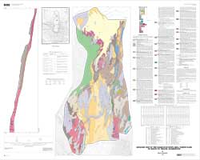The 1980 eruption of Mount St. Helens resulted in both new volcanic deposits and deeply incised exposures into pre-1980 deposits. These exposures were produced by excavation of the crater by the 1980 landslides and lateral explosion as well as the subsequent erosion of Step and Loowit creeks by northerly stream flow out of the horseshoe-shaped crater. The map covers the area known as the Sasquatch Steps (commonly called the Steps), which lies between the Pumice Plain on the north and the lowermost portion of the crater on the south. Rapid alluvial aggradation at the base of the Steps is presently burying some of the lowest exposures, and erosion is stripping many of the upland deposits. The stratigraphic sequence exposed in the map area includes deposits from the eruptive periods listed in table 1 (Crandell, 1987). Assignment of deposits to the various eruptive periods is based on lithology and ferromagnesian-mineral suites typical for each of the eruptive periods (Mullineaux and Crandell, 1981; Mullineaux, 1986), as well as three 14 C dates from wood found in the deposits. Faults displayed on the map are largely confined to the older part of the stratigraphic section. These older units are highly shattered, with an extremely complicated fracture pattern, and it is only possible to show the largest and most distinctive of these structures at the map scale. Interpretation of the stratigraphy and structure of this area is given in Hausback and Swanson (1990).


